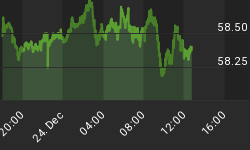
www.cartoonstock.com
Most recently the current investor sentiment got a lot of press around the blogosphere, regularly picking out the rapid increases in bullish sentiment and it's most probably negative (contrary) implications for the market's short- and intermediate term performance.
For example: For the week ending 12/23/2010, the American Association of Individual Investors (AAII) sentiment survey was reported at 63.3% bulls and 16.4% bears (bulls significantly above the long-term average of 39%, and bears significantly below the long-term average of 30%, and the highest reading for the bulls since August 19, 2005), (courtesy of) Investor Intelligence US Advisors Sentiment bulls (data at 58.8% and bears at 20.6%, and finally the Market Vane Bullish Consensus (tracking the buy and sell recommendations of leading market advisers and commodity trading advisers) at 60%, the highest reading since November 9, 2007.
But its always better to question any prevailing dogma or market adage, especially when those dogmas are rarely backed up by the numbers (the numbers don't lie). Therefore I checked for the following setups (when they were triggered the first time, means no consecutive occurrences were taken into account):
- Investor Intelligence US Advisors Sentiment bulls at 58.0%;
- Investor Intelligence US Advisors Sentiment Bulls to Bear Ratio ≥ 2.75;
- Market Vane Bullish Consensus ≥ 60%; and
- AAII Bulls > 60% or Bears < 20% and SPY (S&P 500 SPDR) at the high for the running year during the reporting week (bullish sentiment at potential market tops).
Table I below shows all occurrences and the SPY (S&P 500 SPDR)′s historical performance (since 01/01/1990) over the course of the then following 21 (1 month), 42 (2 months), 63 (3 months), 126 (6 months) and 252 (1 year) sessions, assumed one went long on close of the last session of the respective reporting week (regularly a Friday) when the Investor Intelligence US Advisors Sentiment bulls were reported at or above(≥) 58.0%.

(* no close below trigger day's close during period under review)
When Investor Intelligence US Advisors Sentiment bulls were reported at or above (≥) 58.0% in the past,
- ... chances (and odds) for closing at a higher level 1 and 2 month later were at least in line with at-any-time chances for a higher close 1 and 2 months later;
- ... the SPY (S&P 500 SPDR) closed at a higher level 3 months later on 14 (or 70% of the time), and 6 and 12 months later on 17 out of 20 occurrences (or 85% of the time), (significantly) better than the at-any-time chances of 69.76% and 75.95% for a higher close 6 and 12 months later.
Table II below shows all occurrences and the SPY (S&P 500 SPDR)′s historical performance (since 01/01/1990) over the course of the then following 21 (1 month), 42 (2 months), 63 (3 months), 126 (6 months) and 252 (1 year) sessions, assumed one went long on close of the last session of the respective reporting week (regularly a Friday) when the Investor Intelligence US Advisors Sentiment Bulls to Bear Ratio was reported at or above (≥) 2.75.

(* no close below trigger day's close during period under review)
When Investor Intelligence US Advisors Sentiment Bulls to Bear Ratio was reported at or above (≥) 2.75 in the past,
- ... chances (and odds) for closing at a higher level 1 , 2 , 3 and 6 months later were at least in line (partly better) with at-any-time chances for a higher close 1 , 2 , 3 and 6 months later;
- ... the SPY (S&P 500 SPDR) closed at a higher level 12 months later on 31 out of 35 occurrences (or 88.57% of the time), (significantly) better than the at-any-time chance of 75.95% for a higher close 12 months later.
Table III below shows all occurrences and the SPY (S&P 500 SPDR)′s historical performance (since 01/01/1990) over the course of the then following 21 (1 month), 42 (2 months), 63 (3 months), 126 (6 months) and 252 (1 year) sessions, assumed one went long on close of the last session of the respective reporting week (regularly a Friday) when the Market Vane Bullish Consensus was reported at or above (≥) 60%.

(* no close below trigger day's close during period under review)
When the Market Vane Bullish Consensus was reported at or above (≥) 60% in the past,
- ... the SPY (S&P 500 SPDR) closed at a higher level 2 and 3 months later on 31 out of 41 occurrences (or 75.61% of the time), (significantly) better than the at-any-time chance of 63.27% and 65.91% for a higher close 2 and 3 months later;
- ... the SPY (S&P 500 SPDR) closed at a higher level 12 months later on 39 out of 41 occurrences (or 95.12% of the time), (significantly) better than the at-any-time chance of 75.95% for a higher close 12 months later;
- ... the median gains 3 , 6 and 12 months later were 4.94%, 9.67% and 17.71% (!), (significantly) better than the benchmark's at-any-time median gains of 2.77%, 4.68% and 10.01% during a 3, 6 and 12 months time frame.
And last but not least: Table IV below shows all occurrences and the SPY (S&P 500 SPDR)′s historical performance (since 01/01/1990) over the course of the then following 21 (1 month), 42 (2 months), 63 (3 months), 126 (6 months) and 252 (1 year) sessions, assumed one went long on close of the last session of the respective reporting week (regularly a Friday) when AAII Bulls were reported above 60% or Bears were reported below 20% and the SPY (S&P 500 SPDR) closed at the high for the running year at least once during the respective reporting week.

(* no close below trigger day's close during period under review)
When AAII Bulls were reported above 60% or Bears were reported below 20% and the SPY (S&P 500 SPDR) closed at the high for the running year at least once during the respective reporting week in the past, the most notably peculiarity is the fact that the the SPY (S&P 500 SPDR) closed at an even higher level 12 months later on 43 (thereof the last 20) out of 49 occurrences (or 87.75% of the time), (significantly) better than the at-any-time chance of 75.95% for a higher close 12 months later.
Conclusions:
As always everything is possible (a market correction and/or a continuation of the recent run-up in the markets), but at least with respect to the recent bullish extremes in market sentiment indicators (even when they coincided with a market closing at or near the highest level of the running year) I couldn't find any evidence (partly quite the contrary, see Market Vane Bullish Consensus) that - from a historical perspective - they will be indicative for an imminent down-turn in the markets.
Successful trading, and a Happy New Year
















